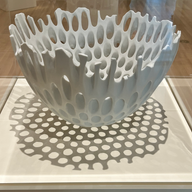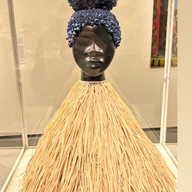A trip to the museum...
Last year I moved just outside of Providence, RI to be closer to my job at The Skating Club of Boston. Providence is a beautiful city with a thriving culture and art scene and it has been really fun to explore. One of my favorite places that I’ve discovered by far is the Rhode Island School of Design’s (RISD) Museum. When I first visited the museum I was amazed by the diversity of the work displayed. Elaborate blown glass chandeliers hung next to abstract black and white photographs. Couture garments hung on mannequins near works by great artists like Monet and Pizarro.
After wandering the many different rooms of the museum for a few hours with my friend I asked him “so what was your winner?” I wanted to know among all of this diverse art, with no real fair way to compare one to another, just what stood out to him. It’s so interesting to me to see what people react to emotionally. A Van Gogh fan, my friend had been struck by a piece by the master artist. He said he couldn’t believe that at one time Vincent himself sat in front of that very same canvas, brush in hand and created the work he stood in front of now. He admired for several minutes the brush strokes, getting in close and squinting, noting the colors, admiring the artist’s workmanship. He’d then back up, looking at the piece from different angles and distances to take it in and admire it fully. When he asked me the same question about what had stood out to me my heart went to this small but intricate handmade needlepoint of blue ombré flowers. The piece was imperfect with some staining from over the years but I knew firsthand the amount of time, skill and care that went into creating this tiny wonder of handwork.
What is so special about figure skating?
I’ve heard it asked often, particularly around the Olympics when a lot of new people are introduced to figure skating, “is it an ART or is it a SPORT?” Even within our sport we’ve struggled with this question for some time. The truth is, at it's best, it's both. It's easy to quantify a performance in most sports. Time can measure who ran or swam the fastest and it is clear to any audience which team got a ball in the goal the most times, but how do you quantify art? How do you compare a landscape by Van Gogh to yards of needlepoint flowers?
For most of the sport’s existence we’ve solved this problem with judges. Sophisticated people with years of experience refining their eye to look at every fine detail. In the days of school figures, judges would stand on the ice hovering over where the skater performed and inspect the tracings made, sometimes on their hands and knees examining the details of the marks on the ice. Then they could walk away from the patch to look for scale and circle size, reviewing the work from every angle. This was one critical way judges rightly evaluated technical ability. After some scandals around the politics of skating in 2004, the judging system of skating was deemed too easy to manipulate and a new, more complicated and quantitative system took its place.
Now accomplished skaters and coaches would serve as technical specialists to evaluate the difficulty of jumps, spins and steps in slow motion video replay. Judges would also evaluate elements individually for quality based on previously specified criteria and grade (at the time) five different characteristics of the routine called components and quantify them individually with a score from 1-10. As a national singles technical specialist myself, I’ve served on 100’s of panels and I can assure you, the judging system we currently use is fair to the skaters. Every skater is evaluated based on the exact same criteria and the standard for one skater is the standard for all skaters in any given event. The thing I find myself struggling with lately is that while I can say without hesitation that the judging system is fair, I can’t say I believe it is set up to produce what I feel is the best skating.
To be clear, I want to say right up front that I think that the organizations that were tasked with trying to create a perfectly fair system of judging that properly balances the value of art and sport did the best job they could do with the experience they had available to them at the time. In some ways I find it to be an impossible task so I use the word "balance" very deliberately. After 2004 something needed to change in the way we evaluated skating. To approach or achieve any balance is an alchemy that requires thoughtful consideration and adjustment to maintain. Now, almost 20 years later, I feel it's a good time to reflect on where we came from, where we are and where would be best for skating, skating fans and our athletes to go next.
I was very fortunate to do an interview with multiple time Olympic Champion choreographer Sandra Bezic in 2020. (You can find the full interview on this blog.) In Sandra's own words about skating and the current judging system...
“I think the numbers game is awful and I think it's also false. Because there’s a false sense of what’s good and what isn’t good.” - Sandra Bezic
What has always made figure skating so special is that it is a blend of sport and art. As I’ve stated already, evaluating the “sport” part is easy. As a technical panel, we can look at a jump in slow motion and determine if it was rotated 4 times or 3 & 3/4 times in the air and the marks for that element will reflect that. However, I don’t feel anyone can properly judge art in the same way we judge sport. At the museum I mentioned earlier, my friend and I viewed hundreds of pieces of different works but in the end, when forced to make a choice we both made a choice by what had moved us. It was the pieces that triggered emotional responses in us that held places in our hearts. My friend responded to Van Gogh because he knows Vincent's story and how he suffered as an artist and that personal story brought out emotion when viewing Van Gogh’s work in person. I looked at the yards of carefully embroidered fabric, each flower so unbelievably detailed and perfect and I thought of the nights I’d watch my mother carefully create using the same medium for hours just to make something so incredibly small. This particular piece at the museum was far more intricate than anything I’d ever seen my mother create. Some of the finer details, like the angles of the threads in different directions in the same color can’t even be observed in the pictures I've provided. You’d have to see the work in person to understand and appreciate them. I thought about the level of skill and the amount of time some master seamstress must’ve spent toiling with that cloth to create something so small but so beautiful.
Skating is sport AND art, to separate them is to deny everything that we hold sacred about figure skating. While I can personally attest to the incredible difficulty of the skills being performed today they are only one part of the sport I love. When I watch skating today, these are all masters of their craft and incredible athletes. However, judged as artists, there have been only maybe a small handful of performances recently that I felt could belong in a museum. This isn't any skater's fault, they want to win and they are working with the parameters we've given them. To try to quantify the value of a performance created by looking at the number of revolutions in the air or the number of strokes on the ice is like judging a painting by the number of colors that were used or the number of brush strokes put to a canvas. It misses the point of why art is created.
Our dictionary defines art as…
“the expression or application of human creative skill and imagination, typically in a visual form, producing works to be appreciated primarily for their BEAUTY OR EMOTIONAL POWER.”
The judging system in its current form I believe does well evaluating the "sport” of a skating performance. Rotation of jumps, positions of spins, even quality and variety of transitions between elements. Where I believe this system fails us is to evaluate and proportionately value the "art” of a skating performance. From my experience the only way to evaluate art is in one simple question… HOW DID IT MAKE YOU FEEL? In my opinion we created a judging system that is good at evaluating sport so that’s what we’ve gotten, good sport. More revolutions, more turns, more positions and more brush strokes. Because this system has become so specific in its criteria, as an art form our canvases (or our ice) has been covered with more and more and more of the same colors and patterns from every single would-be artist. You can look at each little part of it granularly in slow motion like I do as a specialist and get a certain perspective but that is only part of how you should evaluate and appreciate good skating. You have to view it from multiple angles. Where I feel like skating has gotten lost is in trying to judge a performance by the sum of its parts. At the end of the day what matters is when you take a step backwards and absorb a performance as a whole, “how did it make you feel?” “I think in the end, I’m not sure how different placings would be old system vs. new system in a lot of respects. I think the clutter of a performance of a program is overwhelming and at the end of a performance sometimes you can kind of go 'well who cares?” - Sandra Bezic
Spectatorship in figure skating as many have noted has been down and popularity is somewhat waining. This breaks my heart but I can also completely understand why. The experience of watching a “sport” and viewing “art” are two very different things. I can appreciate when someone runs 100 meters in less than 10 seconds, that’s an amazing act of athleticism, but I’m not going to look back at it with wonder in 10 years and want to watch it again. Watching a 97 pound teenager jump into the air and rotate 4 times in just over a half a second is an astonishing act of athleticism. I appreciate how incredible that is, but it’s nothing I’m going to want to see again next weekend or 10 years from now. When art moves us we connect with it, we bond with it, we hang it on our walls to appreciate and enjoy over and over again. I try to go back to that museum every Sunday because I find it fuels my soul in a way that needs replenishing. I find myself watching old skating performances much more than most contemporary ones because flat out, they just feed me more.
When I was a little boy, sitting on my living room floor in 1992, I couldn’t tell you how many turns the skater on tv was doing but I still remember what it felt like when I was jumping out of my seat when their music finished. When Paul Wylie raised his arms in a spread eagle the hair on the back of my neck stood up. Right there, what I connected to was ART. That’s what hooked me and that’s what I fell in love with about what I was watching. THAT is what made me want to be a skater. No one can responsibly ask where our viewership has gone without considering what we have put in front of them to look at.
Where did we come from?
I will proudly wear the badge of an “old school” skater any day of the week. I’m fortunate to spend time with other experienced officials and coaches and I hear the argument a lot from them, “well if we’d only bring back school figures…” Years after figures were removed from our sport, my first coach still insisted that I practice them and learn the basics even though they were no longer required as part of competition. To that woman, Ellen Quinlan Caruso I will forever be in your debt. Do I think skating would be more beautiful and we would see far fewer injuries if athletes today were made to practice school figures? 100% Yes. Do I think that is a realistic solution to where we are now? No… However, I believe there is a lesson to be learned from my little trip to the museum and observing how we’ve changed the way we evaluate skating over the years.
As I’ve stated already, there was a time when the experienced and educated judges stood on the ice and got up super close and evaluate the technical abilities or “craftsmanship” of a skater. Then in the next phase of the competition the judges were asked to stand further back off the ice to observe and evaluate a performance as a whole and give one mark for a skater’s “artistic impression.” This mark was what had made our sport unique and was always where traditionally we had placed the most value in skating.
“I think that figure skating, because it is a performance sport you have to have subjective judging. You can not pretend that a number can judge a performance. A human being has to judge a performance and that human being has to be educated and sophisticated and knowledgeable so that we respect their opinion.” - Sandra Bezic
Where are we now?
My role as a specialist today and how we rightfully evaluate the “sport” part of skating is to be the up close observer. I’m the one at the museum with my face an inch from the piece, looking at the finer details to see if the work was done well. However our knowledgeable judges today are handcuffed nearly just as close as I am to predetermined bullet points and criteria. We ask them to evaluate each individual element just as the technical panel already has and while there are component marks they are still too narrowly focused and separated from the whole. Judges are told specifically what they are allowed to consider and not consider in scoring. Imagine if artists knew this was how their work would be evaluated? What kind of art would they create? What would that museum start to look like? Who stands back now to watch the whole of a performance to determine if it was beautiful? Today it is only our audience and I fear we haven’t given them much to look at.
I'd also like to speak a little to the different types of energy it takes to be a skater. Sport is rewarding but it's also very physically taxing. There's a good reason why we see our top skaters drop off at a certain age. When you reward sport disproportionately to how you reward art you create a much smaller physical "window of opportunity" for a skater to conventionally "succeed." I can't skate 3-5 hours a day like I did in my youth and even when I could it was taxing on my body. If you told me today I could have 3-5 hours a day to craft, DIY, just be creative or make art I would be fully energized every single day to wake up and do so. That was the creative energy that propelled me as a skater through the times when my sport got tough.
Great art can still be created within this system, but it is far and few between and the effort to do so isn’t rewarded as it should be. We still have skaters like Nathan Chen or teams like Papadakis & Cizeron using the system to push themselves to create increasingly intricate pieces, but much of the “art” of our sport has been lost and become homogenized. Even the best skaters (please read “artists”) have to stick to certain formulas in order to be competitive and many of their bodies have given out before they've ever come close to their artistic potential.
So then where do we go?
I’ve heard some pessimistic views that the generation who knew how to teach skating as an art has faded away. They believe coaches today have “sold out” and don’t know how to teach beautiful skating or create inspiring programs like they used to. I wholeheartedly disagree with both sentiments. The problem isn’t that coaches and skaters today don’t know how to create beautiful skating, the problem is that we don’t reward them properly when they do. Coaches, skaters and judges start out just like I did, as little skating fans on the floors of their living rooms being moved emotionally by a performance. Most of us today grew up in the golden age of our sport when there was so much beautiful skating on tv that we just couldn’t wait to watch more the following weekend. Just like how I now find myself going back to the museum every weekend for more and more of what I need.
I like shows like Project Runway, where fashion designers have to create wearable art within certain parameters and then it’s judged. The fun element to the show and what makes it interesting to watch week after week that tests of the designers creativity is that these parameters are constantly changing, much like our system. The designers have to be true masters of their trade in order to succeed. This holistic approach to the competition separates out the stronger designers from the weaker ones. They have to be skilled at all parts of the execution of their craft, but they are still judged as art should be judged… As a whole, by how it made the expert judge and viewer feel. This show has found a balance of judging craftsmanship and creativity that interestingly enough began in 2004 and still remains popular to this day.
“Great people are emerging from this, you still have Jason Brown and you still have all these beautiful performances but it really comes down to coaches and choreographers maintaining their standards and maintaining their ethics about what’s great about figure skating and not just playing a numbers game.” - Sandra Bezic
I don't presume to have all the solutions for where skating should go next. I've intentionally excluded specific plans from this writing. I think just like determining a winner out of Vincent Van Gogh and my little embroidered flowers, it would require quite a few very well educated opinions. I wholeheartedly welcome that conversation and I feel it's our duty to do so. I trust that each person brings a unique perspective to judge art or our judging system for themselves. Whether skating is accounting for the art of our sport properly or not, our viewership is doing so already.
What’s a spectator to think when a performance that makes the hairs on the back of their neck stand up and the skater comes in fifth? From a spectator's perspective, removing school figures made the sport more interesting to watch. Less esoteric judging from up close, more weight put on artistic impression and so more understandable to the public eye. I believe there is a place for both perspectives of judging in skating given the right proportions. Does someone need to stand up close and watch in slow motion to make sure these athletes have mastered their craft? Yes, and I’m happy to do it. Much more importantly to me however, is that we need to give our knowledgeable and experienced judges who know and love skating the freedom to step back and look at a performance as a whole like we ALWAYS have. THAT is how you judge art. If we want skating to continue to be something special in the world of sport we need to understand WHY it is special, give our skaters the space to create to their full potential and honor their art with a proper evaluation.
Thank you for reading.
Disclaimer: Any opinions expressed in this blog are mine personally and not the official opinion of any organization I represent or belong to.








































